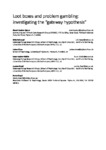Loot boxes and problem gambling: Investigating the “gateway hypothesis”
| dc.contributor.author | Spicer, Stuart | |
| dc.contributor.author | Fullwood, C | |
| dc.contributor.author | Close, James | |
| dc.contributor.author | Nicklin, LL | |
| dc.contributor.author | Lloyd, J | |
| dc.contributor.author | Lloyd, Helen | |
| dc.date.accessioned | 2022-04-13T10:34:34Z | |
| dc.date.available | 2022-04-13T10:34:34Z | |
| dc.date.issued | 2022-08 | |
| dc.identifier.issn | 0306-4603 | |
| dc.identifier.issn | 1873-6327 | |
| dc.identifier.other | 107327 | |
| dc.identifier.uri | http://hdl.handle.net/10026.1/19032 | |
| dc.description.abstract |
Loot boxes are purchasable items in video games with a chance-based outcome. They have attracted substantial attention from academics and legislators over recent years, partly because of associations between loot box engagement and problem gambling. Some researchers have suggested that loot boxes may act as a gateway into subsequent gambling and/or problem gambling. However, such "gateway effects" have not been formally investigated. Using a survey of 1102 individuals who both purchase loot boxes and gamble, we found that 19.87% of the sample self-reported either "gateway effects" (loot boxes causally influencing subsequent gambling) or "reverse gateway effects" (gambling causally influencing subsequent loot box engagement). Both subsets of participants had higher scores for problem gambling, problem video gaming, gambling-related cognitions, risky loot boxes engagement, and impulsivity. These individuals also had a tendency for higher loot box and gambling spend; suggesting that potential gateway effects are related to measurable risks and harms. Moreover, the majority of participants reporting gateway effects were under 18 when they first purchased loot boxes. Content analysis of free text responses revealed several reasons for self-reported gateway effects, the most frequent of which were sensation-seeking, normalisation of gambling-like behaviours, and the addictive nature of both activities. Whilst the cross-sectional nature of our findings cannot conclusively establish directions of causality, thus highlighting the need for longitudinal research, we conclude that there is a case for legislation on loot boxes for harm minimisation purposes. | |
| dc.format.extent | 107327-107327 | |
| dc.format.medium | Print-Electronic | |
| dc.language | en | |
| dc.language.iso | en | |
| dc.publisher | Elsevier | |
| dc.subject | Loot boxes | |
| dc.subject | Problem gambling | |
| dc.subject | Gateway hypothesis | |
| dc.subject | Video games | |
| dc.subject | Impulsivity | |
| dc.subject | Problem video gaming | |
| dc.title | Loot boxes and problem gambling: Investigating the “gateway hypothesis” | |
| dc.type | journal-article | |
| dc.type | Journal Article | |
| dc.type | Research Support, Non-U.S. Gov't | |
| plymouth.author-url | https://www.webofscience.com/api/gateway?GWVersion=2&SrcApp=PARTNER_APP&SrcAuth=LinksAMR&KeyUT=WOS:000802911700014&DestLinkType=FullRecord&DestApp=ALL_WOS&UsrCustomerID=11bb513d99f797142bcfeffcc58ea008 | |
| plymouth.volume | 131 | |
| plymouth.publication-status | Published | |
| plymouth.journal | Addictive Behaviors | |
| dc.identifier.doi | 10.1016/j.addbeh.2022.107327 | |
| plymouth.organisational-group | /Plymouth | |
| plymouth.organisational-group | /Plymouth/Faculty of Health | |
| plymouth.organisational-group | /Plymouth/Faculty of Health/Peninsula Medical School | |
| plymouth.organisational-group | /Plymouth/Research Groups | |
| plymouth.organisational-group | /Plymouth/Research Groups/Plymouth Institute of Health and Care Research (PIHR) | |
| plymouth.organisational-group | /Plymouth/Users by role | |
| plymouth.organisational-group | /Plymouth/Users by role/Academics | |
| dc.publisher.place | England | |
| dcterms.dateAccepted | 2022-03-29 | |
| dc.rights.embargodate | 2022-4-22 | |
| dc.identifier.eissn | 1873-6327 | |
| dc.rights.embargoperiod | Not known | |
| rioxxterms.versionofrecord | 10.1016/j.addbeh.2022.107327 | |
| rioxxterms.licenseref.uri | http://www.rioxx.net/licenses/all-rights-reserved | |
| rioxxterms.type | Journal Article/Review | |
| plymouth.funder | A mixed-method investigation of the gaming/gambling interface and health related harms.::Gamble Aware |


